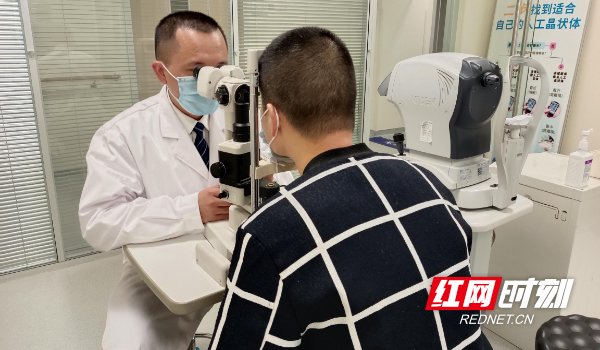
Red Net Moment News April 28th (Correspondent Xie Ping) Cataract It has always been considered to be an exclusive disease of the elderly, but in fact middle-aged and even young people may also suffer from it. The 41-year-old Mr. Xiao recently discovered that he was suffering from this “senile disease”, which was actually caused by diabetes.
According to Mr. Xiao’s recollection, he has been engaged in electric welding for decades, and found that his eyesight had deteriorated more than 10 years ago, but at that time he did not pay attention to it because he was busy with work, thinking that it was due to long-term electric welding. Occupational diseases caused, until the last year, the vision has become more and more unclear, and it has seriously affected the work, and the welding speed and quality have been greatly reduced.
Finally, Mr. Xiao came to Xiangtan Aier Eye Hospital under the introduction of a friend. The medical staff learned through systematic inspection and communication that Mr. Xiao had been suffering from diabetes for more than ten years, and this time it was also a complicated cataract caused by diabetes. “I’m only 41 years old. How can I get cataracts?” Mr. Xiao was surprised. Dean Hu Dong explained that this is different from the often said senile cataract. Complicated cataract refers to the clouding of the lens caused by intraocular diseases. It is also the second common eye complication of diabetes, which usually occurs in the group of diabetic patients. Manifested as decreased vision, glare and so on. The best way is to control blood sugar first, and replace the cloudy intraocular lens through cataract surgery to achieve the purpose of improving vision.
Hu Dong, considering that Mr. Xiao is still so young, has high requirements for visual quality, and he also hopes to return to work as soon as possible. It is Mr. Xiao’s more ideal surgical method to choose refractive cataract surgery with small incision and quick recovery. The operation time was finalized, and Hu Dong personally performed phacoemulsification + refractive intraocular lens implantation for him. At present, Mr. Xiao’s vision has improved to 0.8, but he still needs to keep blood sugar and blood pressure in a stable range after surgery and follow the doctor’s advice. , review regularly.
Hu Dong introduced that the risk of cataract in diabetic patients is 4 to 5 times higher than that in non-diabetic patients. Diabetic-complicated cataract develops earlier, develops faster, has higher nuclear hardness and is more severe. , the lens can quickly become cloudy in a short period of time, and vision can be severely reduced. In addition, diabetic patients have the characteristics of high blood sugar and difficult wound healing. If the operation is performed at a later stage, the difficulty and risk of the operation will be greatly increased.
In order to detect and treat eye lesions caused by diabetes in a timely manner, diabetic patients should receive regular eye examinations, regardless of whether there are changes in vision. For the treatment of diabetic cataract, the appropriate treatment plan can be selected according to the stage of the fundus disease and the degree of cataract lens opacity. Of course, it is necessary to cooperate with diabetes drugs to control blood sugar.
Here, Hu Dong reminds everyone: Cataract is the number one blinding eye disease in the world. Although it is most common in middle-aged and elderly people, young people with diabetes or high myopia should also pay enough attention.